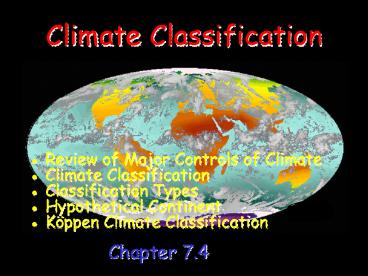Climate Classification PowerPoint PPT Presentation
1 / 25
Title: Climate Classification
1
Climate Classification
- Review of Major Controls of Climate
- Climate Classification
- Classification Types
- Hypothetical Continent
- Köppen Climate Classification
- Chapter 7.4
2
Major Controls of Climate
____________________________
- Latitude
- Atmospheric circulation
- ITCZ, STH, Polar Front, Polar Highs
- Oceanic circulation
- Warm versus cold currents
- Distribution of land and sea
- Maritime versus continentality
- Orography
3
Climate Classification
____________________________
- An aim of climatology has been to develop a
regional climatology of the Earth - The objective is to develop succinct descriptions
of climatic conditions likely to be encountered
at any point on Earth
4
Climate Classification
____________________________
- A climate classification scheme leads to the
creation of a series of climate types - Provided the scheme leads to a manageable number
of these, they can be mapped to produce climate
regions
5
Classification Types
____________________________
- Climate Classification schemes can be divided
into two types
6
Classification Types
____________________________
- Genetic
- Emphasizes the role of the climate controls
(atmospheric dynamics) in creating climate and
its various regional expressions - Relates to the origin of the features
7
Classification Types
____________________________
- Empirical
- Aims to produce a quantitatively defined series
of distinct regions without regard to the causes
of the climate - Relates to the observation of features
8
Climate Classification
____________________________
- Most climate classification schemes are empirical
in nature - While an empirical classification can be based on
any observed climate variable, temperature and
precipitation are the most commonly used
9
Climate Classification
____________________________
- Temperature
- Hot
- Warm
- Cool
- Cold
- Small or large continentality
10
Climate Classification
____________________________
- Precipitation
- No dry season
- Short dry season
- Long dry season
- No wet season (arid)
- Summer dry or winter dry
11
Climate Classification
____________________________
Cold/Tundra
No Dry Season
Continental
Temperate Summer Dry
Temperate Moist
Hot and Dry
Hot Long Dry Season
Hot Short Dry Season
Hot and Wet Hot and Wet
12
Subtropical HighsCross Section across Continents
____________________________
Conditionally unstable,
Stable,
rising air
sinking air
H
East coast
Ocean
West coast
13
Climate Classification
____________________________
- Many classifications have been proposed
- Thornthwaite
- Based on the surface water balance
(precipitation, evaporation, and their seasonal
variations) - Köppen
- Based on temperature and precipitation
- Heavily influenced by vegetation thresholds
14
Köppen Climate Classification
____________________________
- Based on observed temperature and precipitation
measurements
15
Köppen Climate Classification
____________________________
- Each climate region is categorized by a series or
two or three letters - The first letter initially separates dry from
moist climates and then, for the latter, divides
them on the basis of temperature
16
Köppen Climate Classification
____________________________
- A second letter then defines the degree of
aridity for the dry climate and the temporal
distribution of precipitation for the moist ones - A third letter is used to characterize the
seasonal variations in temperature for mid- and
high-latitude climates
17
Köppen Climate Classification
____________________________
- A Tropical Climates
- Hot to warm all year
- Af Rainy all year
- Am Short to medium length dry period
(monsoonal) - Aw Long dry season
18
Köppen Climate Classification
____________________________
- B Dry Climates
- Evaporation exceeds precipitation on average
throughout the year - BW arid climates
- BS semi-arid climates
- h warm/hot temperatures
- k cool temperatures
19
Köppen Climate Classification
____________________________
- C Mesothermal Climates
- Warm summers and cool winters
- Cf moist all year
- Cs summer dry
- Cw winter dry
- a hot summer
- b warm summer
- c cool summer
20
Köppen Climate Classification
____________________________
- D Microthermal Climates
- Warm summers and cold (severe) winters
- Df moist all year
- Ds summer dry
- Dw winter dry
- a hot summer
- b warm summer
- c cool summer
21
Köppen Climate Classification
____________________________
- E Polar Climates
- These climates have no true summers
- ET no true summers
- EF Perennial ice
22
Köppen Climate Classification
____________________________
- H Highland Climates
- Temperatures similar to E climates, but due to
altitude - Not a climate region originally defined by Köppen
23
Köppen Climate Classification
____________________________
Figure 7.10
24
Köppen Climate ClassificationSan Francisco and
Boulder
____________________________
- San Francisco Mediterranean Climate
- Csb Climate
- C mesothermal climate
- s dry summer
- b warm summer
- Boulder Mid-Latitude Steppe Climate
- BSk Climate
- B dry climate
- S semi-arid climate
- k cool temperatures
25
(No Transcript)

